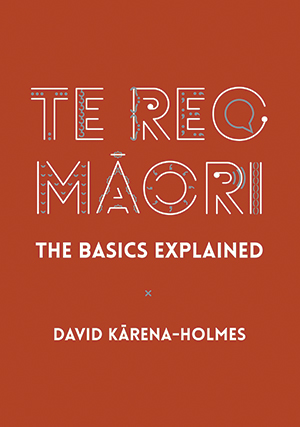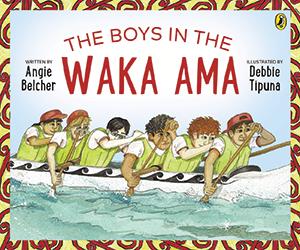Reviews
Mar 27, 2020

Te Reo Māori: The Basics Explained
Nā David Kārena-Holmes
Oratia Press
RRP: $34.99
Review nā Anna Brankin
 This pukapuka was written – or rewritten – by author and language teacher David Kārena-Holmes in response to increasing demand for Māori language resources throughout the country. He describes it as “essentially a complete rewrite” of his earlier book, Māori Language: Understanding the Grammar.
This pukapuka was written – or rewritten – by author and language teacher David Kārena-Holmes in response to increasing demand for Māori language resources throughout the country. He describes it as “essentially a complete rewrite” of his earlier book, Māori Language: Understanding the Grammar.
The preface of Te Reo Māori: The Basics Explained states that aspiring speakers of te reo Māori will eventually need a good understanding of grammar to progress beyond beginner level – and it also acknowledges the vast differences between te reo Māori and English grammar. Having been described as a “grammar nerd” on more than one occasion, and with fluency in te reo Māori sitting at the top of my New Year’s resolutions for another year running, I was optimistic when I sat down to flick through this pukapuka. However, prospective readers who don’t share my passion for grammar will be pleased to learn that the book assumes no prior knowledge, and instead uses everyday language to explain the differences between pronunciation and sentence structures in te reo Māori and the English language.
A quick glance at the contents page reveals a straightforward and methodical approach, with the book divided into bite-sized chunks that guide readers from the very beginning – pronunciation – through to forming phrases, sentences and questions. It is no surprise that 30 years as a tutor of te reo Māori has given the author an insight into the easiest way to teach the language.
Each section of the book focuses on a different grammatical building block – the main base words and the particles and determiners that guide their use – and provides simple examples to help you understand what these are in English, before explaining the equivalent in te reo Māori. Frequent examples throughout, as well as thoughtful use of capitalisation and bold font, allow the reader to easily identify the grammatical convention being explained, which in turn makes it easier to replicate.
This is a fantastic resource for learners and speakers of te reo Māori. Not to be read in one sitting, it is instead a perfect addition to your reference collection, and I can guarantee I will be reaching for it regularly as I continue my learning journey.
 Anna Brankin (Ngāi Tahu – Ōraka Aparima) is a senior writer and editor within the Communications team at Te Rūnanga o Ngāi Tahu and the assistant editor of TE KARAKA. She is an avid reader and worked in a second-hand bookstore before coming to work for her iwi.
Anna Brankin (Ngāi Tahu – Ōraka Aparima) is a senior writer and editor within the Communications team at Te Rūnanga o Ngāi Tahu and the assistant editor of TE KARAKA. She is an avid reader and worked in a second-hand bookstore before coming to work for her iwi.
The Boys In The Waka Ama
Nā Angie Belcher rāua ko Debbie Tipuna
Penguin Books
RRP: $18.99
Review nā Allanah Burgess rātou
ko Kaia Waaka (5), ko Maika Waaka (3).
 We were so happy to receive this pukapuka for review because (as regular readers of TE KARAKA will know) we so greatly enjoyed reading its predecessor, The Girls in the Kapa Haka. Both of my tamariki didn’t know much about waka ama, but they immediately related this book to The Girls in the Kapa Haka.
We were so happy to receive this pukapuka for review because (as regular readers of TE KARAKA will know) we so greatly enjoyed reading its predecessor, The Girls in the Kapa Haka. Both of my tamariki didn’t know much about waka ama, but they immediately related this book to The Girls in the Kapa Haka.
Waka ama is becoming increasingly popular here in Aotearoa, and Kaia and Maika are now asking questions about this fast-growing sport – including when they will get a chance to be part of a team like the one in the book and hoea the waka too.
The singing text and beautiful illustrations kept my tamariki engaged in the narrative. Kaia was able to notice the rhyming words and the pictures provided talking points to prompt further discussion for the tamariki about what is happening in the story, using their own words as well as incorporating new ones they have heard. The tamariki were telling me about all the different places they have seen a waka before and asked about the safety boat that was following the boys throughout the race. They mentioned the kōwhaiwhai patterns they have seen at the marae and could point out the paddles and harakeke on the inside of each page.
Detail of the water and expressions on the boys’ faces helped the tamariki understand the conditions and how hard it must have been for the boys to paddle. They could also tell me when the boys were tired and when they were so happy they had won their race!
Showing the whānau support on the shorelines was a lovely touch and demonstrated to the tamariki how much encouragement they gave them throughout their race. Key words such as ‘Kia kaha’ and ‘Kia tere’ supported the use of te reo and added to the bank of kupu hou for Kaia and Maika.
Maika thought: “They are doing a pukana before the race because maybe that is getting them ready!”
Towards the end Kaia felt very proud of the boys and said: “OMG! They must work so hard! They are up so early, and their day is so long.”
The acknowledgement of karakia was awesome to see and normalised it for my tamariki. Maika said he knows he does it before kai time but didn’t know the boys did it to help them win the race.
Showing the importance of teamwork proved to my tamariki that we can do anything when we work together and put it into practice.
Kaia mentioned at the end of the book: “She is sure that girls can do the waka ama pai as well.” Maika replied: “Yeah, well the boys can do the kapa haka too.” Together we decided we are all capable of anything we set our minds too.
We all loved the ending and joined in together: “Tahi, rua, toru, whā, hī!”
It was great to see the glossary at the back with helpful hints for correct pronunciation – not just another great pukapuka, but a fantastic resource for basic language learners.
Five twinkly stars were agreed on.
 Allanah Burgess (Te Āti Awa, Ngāi Tahu) is the Manager of Waikawa Marae, Picton and a proud māmā to her two beautiful tamariki Kaia (4) and Maika (3) Waaka. They have just relocated from Ōtautahi back home to Waikawa ki Te Tau Ihu. Kaia is a creative kōtiro who enjoys reading, art and role play. She has just found a new love for kapa haka and enjoys spending time with her whānau. Maika is very competitive and loves being outdoors, especially in, on, or around water.
Allanah Burgess (Te Āti Awa, Ngāi Tahu) is the Manager of Waikawa Marae, Picton and a proud māmā to her two beautiful tamariki Kaia (4) and Maika (3) Waaka. They have just relocated from Ōtautahi back home to Waikawa ki Te Tau Ihu. Kaia is a creative kōtiro who enjoys reading, art and role play. She has just found a new love for kapa haka and enjoys spending time with her whānau. Maika is very competitive and loves being outdoors, especially in, on, or around water.
Opinions expressed in REVIEWS are those of the writers and are not necessarily endorsed by Te Rūnanga o Ngāi Tahu.